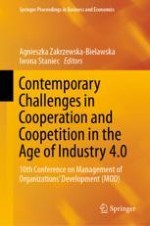2020 | OriginalPaper | Chapter
22. Chosen Aspects of Co-creating an Employer’s Image by Employees as Prosumers
Author : Agnieszka Izabela Baruk
Published in: Contemporary Challenges in Cooperation and Coopetition in the Age of Industry 4.0
Publisher: Springer International Publishing
Activate our intelligent search to find suitable subject content or patents.
Select sections of text to find matching patents with Artificial Intelligence. powered by
Select sections of text to find additional relevant content using AI-assisted search. powered by
